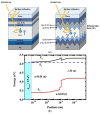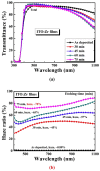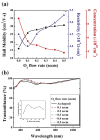A Brief Review of Transparent Conducting Oxides (TCO): The Influence of Different Deposition Techniques on the Efficiency of Solar Cells
- PMID: 37049320
- PMCID: PMC10096935
- DOI: 10.3390/nano13071226
A Brief Review of Transparent Conducting Oxides (TCO): The Influence of Different Deposition Techniques on the Efficiency of Solar Cells
Abstract
Global-warming-induced climate changes and socioeconomic issues increasingly stimulate reviews of renewable energy. Among energy-generation devices, solar cells are often considered as renewable sources of energy. Lately, transparent conducting oxides (TCOs) are playing a significant role as back/front contact electrodes in silicon heterojunction solar cells (SHJ SCs). In particular, the optimized Sn-doped In2O3 (ITO) has served as a capable TCO material to improve the efficiency of SHJ SCs, due to excellent physicochemical properties such as high transmittance, electrical conductivity, mobility, bandgap, and a low refractive index. The doped-ITO thin films had promising characteristics and helped in promoting the efficiency of SHJ SCs. Further, SHJ technology, together with an interdigitated back contact structure, achieved an outstanding efficiency of 26.7%. The present article discusses the deposition of TCO films by various techniques, parameters affecting TCO properties, characteristics of doped and undoped TCO materials, and their influence on SHJ SC efficiency, based on a review of ongoing research and development activities.
Keywords: ITO thin films; TCOs; deposition techniques; optical properties; silicon heterojunction solar cells.
Conflict of interest statement
The authors declare no conflict of interest.
Figures








Similar articles
-
Silicon Heterojunction Solar Cells with Nanocrystalline Silicon Oxide Emitter for Achieving High Fill Factor.ACS Nano. 2025 Jun 10;19(22):20905-20913. doi: 10.1021/acsnano.5c03395. Epub 2025 May 28. ACS Nano. 2025. PMID: 40435513
-
Source Material Design for Realizing >50% Indium-Saving Transparent Electrode toward Sustainable Development of Silicon Heterojunction Solar Cells.ACS Appl Mater Interfaces. 2025 Jan 15;17(2):3265-3277. doi: 10.1021/acsami.4c15684. Epub 2025 Jan 3. ACS Appl Mater Interfaces. 2025. PMID: 39749871
-
Raytracing Modelling of Infrared Light Management Using Molybdenum Disulfide (MoS2) as a Back-Reflector Layer in a Silicon Heterojunction Solar Cell (SHJ).Materials (Basel). 2022 Jul 19;15(14):5024. doi: 10.3390/ma15145024. Materials (Basel). 2022. PMID: 35888490 Free PMC article.
-
A Review of Transparent Conducting Films (TCFs): Prospective ITO and AZO Deposition Methods and Applications.Nanomaterials (Basel). 2024 Dec 14;14(24):2013. doi: 10.3390/nano14242013. Nanomaterials (Basel). 2024. PMID: 39728550 Free PMC article. Review.
-
Advancements in Transparent Conductive Oxides for Photoelectrochemical Applications.Nanomaterials (Basel). 2024 Mar 27;14(7):591. doi: 10.3390/nano14070591. Nanomaterials (Basel). 2024. PMID: 38607125 Free PMC article. Review.
Cited by
-
Impact of Temperature Optimization of ITO Thin Film on Tandem Solar Cell Efficiency.Materials (Basel). 2024 Jun 6;17(11):2784. doi: 10.3390/ma17112784. Materials (Basel). 2024. PMID: 38894047 Free PMC article.
-
The Impact of Substrate Temperature on the Adhesion Strength of Electroplated Copper on an Al-Doped ZnO/Si System.Materials (Basel). 2024 Oct 10;17(20):4953. doi: 10.3390/ma17204953. Materials (Basel). 2024. PMID: 39459657 Free PMC article.
-
Experimental and theoretical aspects of the growth of vertically aligned CNTs by CCVD on AZO substrate.Sci Rep. 2024 Mar 27;14(1):7307. doi: 10.1038/s41598-024-57862-w. Sci Rep. 2024. PMID: 38538805 Free PMC article.
-
Comparative investigations of structural, electronic, optical, and thermoelectric properties of pure and 2 at. % Al-doped ZnO.J Mol Model. 2023 Oct 17;29(11):343. doi: 10.1007/s00894-023-05750-x. J Mol Model. 2023. PMID: 37847327
-
High Aspect Ratio Silver Nanogrids by Bottom-Up Electrochemical Growth as Transparent Electrode.ACS Appl Opt Mater. 2024 Mar 13;2(3):508-516. doi: 10.1021/acsaom.4c00037. eCollection 2024 Mar 22. ACS Appl Opt Mater. 2024. PMID: 38544699 Free PMC article.
References
-
- Chavan G.T., Amate R.U., Lee H., Syed A., Bahkali A.H., Elgorban A.M., Jeon C.W. Rational design of 3D hollow cube architecture for next-generation efficient aqueous asymmetric supercapacitors. J. Energy Storage. 2023;61:106757. doi: 10.1016/j.est.2023.106757. - DOI
-
- Chavan G.T., Shinde N.M., Sabah F.A., Patil S.S., Sikora A., Prakshale V.M., Kamble S.S., Chaure N.B., Deshmukh L.P., Kim A., et al. Chemical synthesis of Cd1−x−yZnxCuySzSe1−z composite thin films for photoelectrochemical solar cell. Appl. Surf. Sci. 2022;574:151581. doi: 10.1016/j.apsusc.2021.151581. - DOI
-
- Dharmadasa I., Burton R., Simmonds M. Electrodeposition of CuInSe2 layers using two electrode system for applications in multi-layer graded band gap solar cells. Sol. Energy Mater. Sol. Cells. 2006;90:2191–2200. doi: 10.1016/j.solmat.2006.02.028. - DOI
-
- Sciuto G.L., Capizzi G., Shikler R., Napoli C. Organic solar cells defects classification by using a new feature extraction algorithm and an EBNN with an innovative pruning algorithm. Int. J. Intell. Syst. 2021;36:2443–2464. doi: 10.1002/int.22386. - DOI
Publication types
Grants and funding
LinkOut - more resources
Full Text Sources

